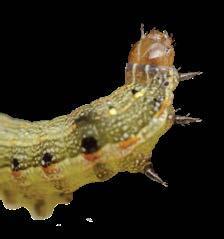
3 minute read
Emerging threat – serpentine leaf miner
Serpentine leaf miner Photo courtesy of National Plant Protection Organization, the Netherlands (insectimages.org)
By Anna Rathé : Biosecurity Manager, HortNZ
The situation
The serpentine leaf miner (Liriomyza huidobrensis) has recently been detected in Australia for the first time. A report from a market garden in Western Sydney was confirmed to be serpentine leaf miner in late October 2020. This was followed by a detection in Queensland in November 2020. Australian authorities are responding and have undertaken surveillance and tracing to determine the extent of the infestation. It appears that eradication in New South Wales is unlikely to be technically feasible due to the extent of the infestation, requiring a transition to management. Originally from South America, this pest has proven itself to be highly invasive, as demonstrated by its spread around the world. It is now present in a number of countries in Europe, Asia, North America (Canada only), Central America and Africa. Its presence in Australia means the pest is one step closer to New Zealand.
The threat
Serpentine leaf miner feeds on over 300 plant species, including vegetables, legumes and ornamentals. Serpentine leaf miner has long been on the radar for both the fresh and processed vegetable industries, with the changing situation offshore closely watched. The insect is also on Biosecurity New Zealand’s priority pest and disease list, reinforcing the significant threat that it poses to plant health in New Zealand.
Larvae are colourless to start with and become pale yellowwhite-orange with a maximum size of 3.2mm in length

Serpentine leaf miner is considered a horticultural threat as the maggot (the larval stages of the fly) tunnels through the leaves of host plants such as onion, celery, beans, garlic, lettuce, pea, beetroot, spinach, potatoes, tomatoes and marrow as it feeds. This leaf damage reduces the plant’s ability to photosynthesise, slowing growth and reducing productivity. Once established, serpentine leaf miner can be difficult to control due to development of pesticide resistance.
The Ministry for Primary Industries (MPI) has strict measures in place to limit the chances of the serpentine leaf miner making it through the border hidden in imported fresh cut flowers, nursery stock or fresh produce from countries that have established populations of the pest.
What can you do?
We encourage all growers to keep an eye out for any telltale signs of leaf miner infestation. This includes scouting commercial outdoor vegetable crops, covered crops and inspecting home vegetable patches. While there are other leaf miner species present in New Zealand, serpentine leaf miner damage is relatively distinctive, with snakelike and irregular leaf mines. Larvae may be present on leaves or inside leaf mines. They are colourless to start with and become pale yellow-white-orange with a maximum size of 3.2mm in length. Adult flies are very small – less than 3mm and grey/black in colour with bright yellow patches on their head and at the base of their wings.
Report biosecurity threats by calling the MPI Pest and disease hotline on 0800 80 99 66.
If the pest were to arrive in New Zealand, early detection maximises our chance of eradication. Under the Biosecurity Act 1993 New Zealanders are expected to report the presence of what appears to be an organism not normally seen or otherwise detected in New Zealand – this would include suspect serpentine leaf miner. If you think you’ve seen the pest do the right thing and catch it (or collect the leaf), snap a photo of the insect (and/or its damage), and report it by calling the MPI Pest and disease hotline on 0800 80 99 66.











